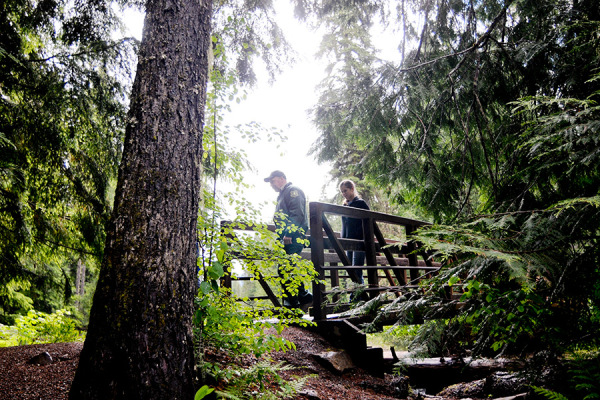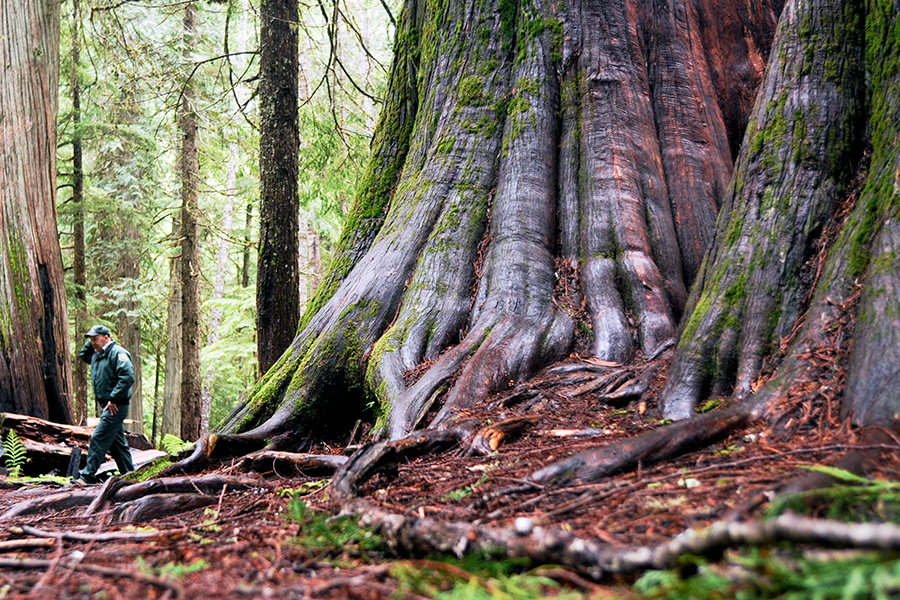Near the lowest point in Montana, some of the largest and oldest trees in the state stretch toward the clouds. South of Troy off Montana Highway 56, a grove of western red cedars lives tucked inside a dense 100-acre site called Ross Creek Cedars. Most of the trees are almost 10 feet in diameter and were born around the time Columbus was discovering the New World.
“As a kid,” says Rachel Reckin, “I just loved the idea that these were 500-year-old trees, and who would’ve been here then, and what the world would’ve looked like and how everything would’ve been different. If only they could talk.”
It’s a hot summer day, or at least it is in the parking lot. Stepping onto the Ross Creek Cedars nature trail, the temperature begins to drop. Sunlight breaks through the canopy and illuminates the forest, exposing a gallery of greens, every shade. The ancient trees, with silver wrinkles of bark, look monolithic. It beckons to the old world.
Reckin and generations of people love this place for exactly that reason. A Libby native, Reckin is the district archaeologist for the Three Rivers Ranger District, which encompasses the northwest portion of the Kootenai National Forest and much of the Scotchman Peaks proposed wilderness, including Ross Creek Cedars.
Reckin and others have discovered signs of human activity dating back almost 8,000 years in this lush corridor hugging the Idaho and Montana border. This is the traditional territory for the Kootenai, Salish and Pend d’Oreilles tribes. They were foraging tribes, hunting and gathering among the Kootenai, Bull and Clark Fork river valleys. Because of the tempestuous ecosystem, organic artifacts did not preserve over time. But Reckin has found pieces of bones and old stone tools, lithics of ancient people.
The most noticeable remnants of the old world, though, are the cedars.
Western red cedars are native to this part of the West and can grow over 200 feet tall and 13 feet wide. They commonly live for hundreds of years. The oldest on record was verified to be 1,460. Cedars rot from the inside out, making it difficult to determine age. Those at Ross Creek are believed to be at least 500 years old, according to the local ranger district, but some could be closer to 1,000.
During the peak of summer, between 300 and 500 people on average daily visit the one-mile stretch of trail winding through the cedars. Mark Mason, the district’s recreation specialist who has worked for the U.S. Forest Service since 1979, has seen vehicles arrive from all over the U.S. and Canada.
“A lot of people love it. Everybody kind of has their own little thing they like best about it,” he says. “Some people like the big trees. Some people like the quietness.”
Coincidentally, as Mason and Reckin walk through the grove with a reporter, a family from Lawton, Okla., ambles up the trail.
“We were in Canada and detoured about two hours out of the way because we wanted to come see,” says the father, Howard Hampton, with his wife, Cathy, and two children. “Just an opportunity to walk through such a majestic place was well worth the trip.”
As the family continues down the trail, Mason says with a smile, “I didn’t set that up, I promise.”
Almost two weeks ago, experiencing the cedars would not have been possible for the Hamptons. The mighty Ross Creek, named after two brothers who prospected nearby for gold and silver in the 1930s, is the dominant force here. During a wet spring and early summer like this one, the creek cuts new channels, occasionally engulfing most of the trail.
But on this day the trails are drying up. With a little help. A Forest Service crew and a group of high schoolers in the Youth Conservation Corps are hauling wheelbarrows full of gravel to pour over wet and rugged spots.
Ross Creek Cedars is the most popular site on the district alongside Kootenai Falls. Maintaining it is a priority, and national forest officials face constant challenges. Flooding is one. Graffiti is another. A couple large trees, over five feet wide and hundreds of years old, have been disfigured with initials and callow doodles cut with knives.
“Most people in here are great. They do a great job and we don’t have any litter,” Mason says. “But unfortunately we have a little trouble with people carving.”

The importance of protecting and preserving these trees is underscored by how resilient they’ve been throughout history.
“They’re remarkable in that they’ve survived for so long,” Reckin says.
Another threat emerged in the early 20th century when Europeans introduced blister rust, a nonnative fungus. It specifically targets white pines and infects the trees, eventually killing them. It destroyed all of the white pines in the Ross Creek area, leaving the cedars as the lone stand.
The great fires of 1889 and 1910 swept the Northwest and erased most of the region’s forests. Cedars naturally burn like match sticks. But not these cedars. Because of their location at low elevation, the Ross Creek grove is within its own microclimate. It’s densely wet, similar to the Pacific Coast where the famed Redwoods grow. There are signs of fire still scarring some local cedars, but as a whole the family of trees have dodged decimation.
This sole survivorship did not help these wooden gems stay inconspicuous. Around this same time, logging was in its heyday. As a highly desirable commodity, cedars were commonly searched for and harvested. However, as Mason and Reckin say, the local loggers realized this piece of land was worth leaving intact.
“The loggers protected it and they and the community saw it as a unique area,” Mason says. “They actually urged the Forest Service to protect it.”
On Sept. 16, 1959, the federal government officially designated the 100-acre Ross Creek Cedars section as a Scenic Area. This protected the land solely for recreational use and scientific research.
Part of that agreement includes leaving downed trees as they are. Forest Service crews will clear hazards off the trail, but beyond that the scenery is left alone in its natural state. Even though the insides rot out first, the big trees can persevere for a long time before tumbling over. Currently there are several standing with hollow insides, large enough for a family to occupy.
Reckin points out a massive dead tree sprawled across the forest floor. Inside its rotted bark, among wild flowers, a new cedar has sprouted.
It’s these downed trees that helped the native peoples survive for hundreds of years. The trees provided resources like bark and roots. They created homes for wildlife and helped the tribes flourish.
“These big trees certainly played an important part,” Reckin says.
“When you talk to the Kootenai folks, the natives who lived in this area, they love Ross Creek,” she adds. “It feels like a remnant, to them, of the past.”
For more information on Ross Creek Cedars, call Three Rivers Ranger District at (406) 295-4693.
